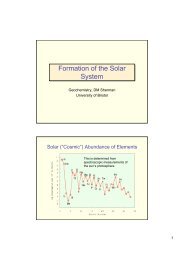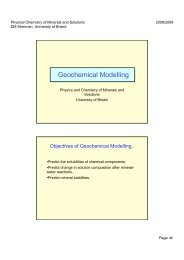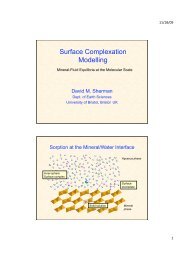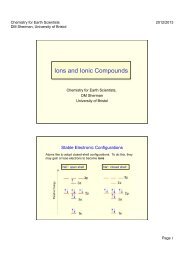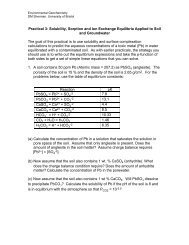Lecture Notes (PDF) - Aqueous and Environmental Geochemistry
Lecture Notes (PDF) - Aqueous and Environmental Geochemistry
Lecture Notes (PDF) - Aqueous and Environmental Geochemistry
You also want an ePaper? Increase the reach of your titles
YUMPU automatically turns print PDFs into web optimized ePapers that Google loves.
Estuaries<br />
<strong>Environmental</strong> <strong>Geochemistry</strong><br />
DM Sherman, University of Bristol<br />
Significance of Estuaries<br />
Estuaries are major<br />
habitats for wildlife.<br />
Many estuaries are<br />
greatly impacted by<br />
urban <strong>and</strong> agricultural<br />
runoff.<br />
1
Significance of Estuaries (UK)<br />
Geochemical Significance of Estuaries<br />
Interface between Rivers <strong>and</strong> Seawaters:<br />
determines flux of chemical species into the ocean.<br />
Riverine pollutants react with seawater <strong>and</strong> may be<br />
accumulated in estuarine sediments.<br />
Chemical Processes:<br />
• Mixing between River water <strong>and</strong> Seawater<br />
• Change in ionic strength<br />
• Change in pH<br />
• Colloid flocculation<br />
2
Rivers vs Seawater<br />
Concentration<br />
in Average<br />
River (mmol/<br />
kg)<br />
Seawater<br />
Concentration<br />
(mmol/kg)<br />
(M/Cl)sw<br />
(M/Cl)riv<br />
pH 5 - 7 8.3<br />
Cl - 0.16 54.6 1<br />
Na + 0.224 48.0 0.62<br />
Mg +2 0.138 5.4 0.11<br />
SO<br />
-2<br />
4 0.068 2.9 0.12<br />
Ca +2 0.334 1.0 0.009<br />
K + 0.033 1.0 0.09<br />
HCO 3 0.852 0.211 0.0007<br />
Br - -- 0.087<br />
H 4 SiO 4 0.173 0.10 0.002<br />
Colloids<br />
Colloids are very small particles that remain<br />
suspended in aqueous solutions. Much of the<br />
chemical flux in rivers in in the colloidal form.<br />
Primary colloidal phases in Rivers are:<br />
• Clay minerals (kaolinite, montmorillonite)<br />
• Iron (hydr)oxides (goethite, hematite, ferrihydrite).<br />
• Humic/Fulvic acids associated with FeOOH.<br />
3
Colloidal, particulate <strong>and</strong> dissolved<br />
In practice, everything that passes through a 0.2 µm<br />
filter is classed as dissolved. However, this includes<br />
much of the colloidal fraction.<br />
Surface Charge of Colloids<br />
+1/2 -1/2<br />
-1/2<br />
Surface charge is a function of<br />
pH, reflecting the variable<br />
protonation of surface oxygens.<br />
At the pH pzc , the surface charge<br />
is zero.<br />
4
Sorption of Metals on Colloids<br />
Sorption of Cu +2 , Ni +2 on Goethite<br />
Recall that sorption onto<br />
FeOOH minerals is a major<br />
control on the dissolved<br />
concentrations of metals.<br />
Colloid Flocculation<br />
Colloids will flocculate when their<br />
surface charge = 0. This will<br />
occur at the pH pzc <strong>and</strong> with<br />
increasing ionic strength.<br />
Flocculation of colloids in<br />
estuaries will incorporate<br />
them (<strong>and</strong> their sorbed<br />
metals) into estuarine<br />
sediments.<br />
5
Behavior during mixing River <strong>and</strong><br />
Seawater<br />
Mechanisms for Removal from Solution<br />
• Increased sorption of cations with increasing pH<br />
• Flocculation of < 0.2 µm colloid particles to decrease<br />
apparent dissolved concentration of Fe<br />
6
Mechanisms for Adding to Solution<br />
Complexation by Cl or HCO 3<br />
-<br />
from seawater causes<br />
desorption from colloidal<br />
FeOOH.<br />
But increasing pH (with<br />
salinity) causes readsorption.<br />
Estuarine Sediments<br />
7
Anoxic Conditions in Estuarine Sediments<br />
As organic matter is<br />
consumed by respiration, O 2<br />
is depleted <strong>and</strong> new electron<br />
acceptors are used.<br />
Anoxic mud<br />
Marine Evaporite Basins<br />
Restricted circulation <strong>and</strong> evaporation leads to increased salinity.<br />
Evaporite mineral sequence reflects relative solubility of CaCO 3<br />
(calcite), Gypsum (CaSO 4. 2H 2 O) <strong>and</strong> Halite (NaCl)<br />
Thermodynamic modelling of evaporite sequences is complicated<br />
by the highly non-ideal activities of ions at high ionic strength.<br />
8
Pollution of Estuaries<br />
Case Study: Hg pollution in California <br />
Hg was used to extract gold<br />
during the California gold<br />
rush. Hg deposits are found<br />
in the Coast Ranges.<br />
Erosion of mine tailings<br />
has led to Hg pollution<br />
of San Francisco Bay<br />
9
The Wheal Jane Spill (Falmouth)..<br />
In 1993 a major spill of mine<br />
waste released serious<br />
amounts of acid mine waste<br />
<strong>and</strong> heavy metals into<br />
Falmouth Bay.<br />
Tamar Estuary (Pb)<br />
Tamar Valley/Buttspiill Mine<br />
10<br />
Depth (cm)<br />
30<br />
50<br />
70<br />
90<br />
2 4 6 8 10<br />
pH<br />
0 2 4 6<br />
Porewater Pb (ppm)<br />
0 1000 2000<br />
Tot. Pb (ppm)<br />
10
Tamar Estuary (Zn)<br />
Depth (cm)<br />
10<br />
30<br />
50<br />
70<br />
90<br />
2 4 6 8 10<br />
pH<br />
0 20 40 60<br />
Porewater Zn (ppm)<br />
0<br />
200<br />
400<br />
600<br />
800<br />
Tot. Zn (ppm)<br />
1000<br />
Summary<br />
• Much of the chemistry of estuaries is controlled by<br />
the flocculation of colloids which may remove some<br />
dissolved ions from solution.<br />
• Some sorbed species (anions) should be released<br />
by increase in pH.<br />
• Sorption at increased pH may incorporate trace<br />
heavy metals into estuarine sediments.<br />
11



